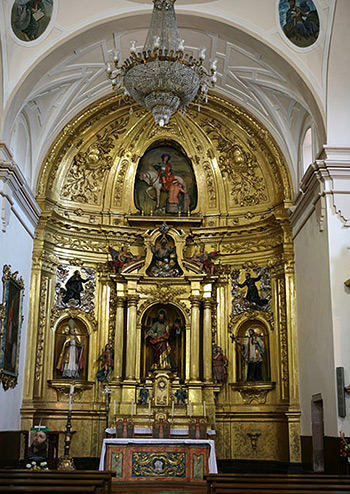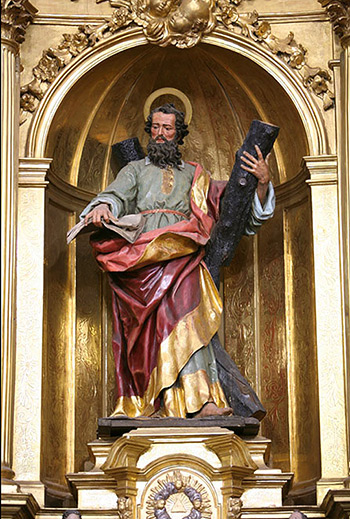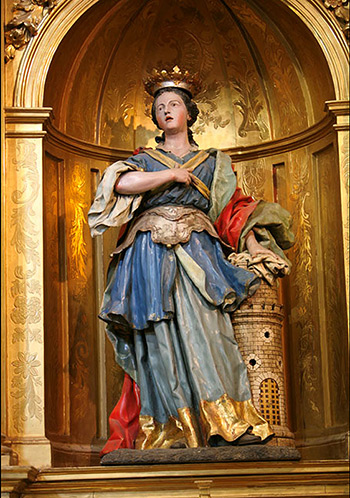Route through the 18th century altarpieces of Baztania
Azpilkueta's altarpieces with outstanding sculptures by Carmona
The combination of a generous patron and an outstanding teacher made this ensemble possible. The patron was a bishop residing in the Indies, Don Martín de Elizacoechea, a native of Azpilkueta and bishop of Michoacán in 1747-1756, after being sponsored by Bishop Castorena and having been canon of the University of Mexico and dean of the New Spain cathedral. He protected his family, rebuilt the native house and the parish church between 1752 and 1754. sample The architect of the altarpieces was Silvestre Soria, whose personality was especially active in the sixties, from his place of residency program, which he established in Pamplona. This master was born in Sesma, in 1715, the place of origin of other important artists such as Roque Solano or Ramón Villodas. Like Solano, Soria was in the Court, where he would contact Diego Martínez de Arce, who recommended him for the execution of the altarpiece of the Purísima Concepción de Elorrio, calling him "architect and decorator". He worked in the new palace of Madrid under the orders of Olivieri and his fame in the Pamplona of the sixties was enormous, being one of the very few cases in which a retablist was given the treatment of "don", as his judgment was sufficient for the awarding of the most outstanding projects. He died in Pamplona in 1768 and, among the most novel data , we have a chronicle of his last days written by a Capuchin for whose convent he had worked on a beautiful scenography for the canonization of Saint Seraphim and Blessed Corleon, which the chronicler judged to be "a new idea and invention never seen in Navarre". He recounts his death in detail, noting his conformity and serenity in his last hours of life. Among his most distinguished works in Navarre we must highlight the set of altarpieces of the basilica of San Gregorio Ostiense and the entire rococo remodeling of the sacristy of the canons of the cathedral of Pamplona.
Another work that Soria would be in charge of around this time would be the set of altarpieces of Azpilkueta. The dating in 1752 of this very important set has been made based on the date of a signature of the sculptor Luis Salvador Carmona in one of the sculptures. However, we believe that this chronology must necessarily be delayed because the sculptor, at that time, had not yet settled in Pamplona and, above all, because he had not yet been examined in order to be able to work in the capital of Navarre and the rest of the kingdom. The date of this interesting set of altarpieces should not be far from 1759, the year in which he was examined in Pamplona. When he contracted the main altarpiece of Elizondo in 1762, these altarpieces by Azpilkueta were listed as reference letter recent.
The main altarpiece is a very interesting piece within the works of its kind in Navarre, due to its novelties. It is a strange and novel design that, in that chronology, could only have been designed by Silvestre Soria, a specialist both in ornamentation and in the Baroque and Romanesque architectural layout. Typologically, we find ourselves before a shallow shell altarpiece that covers with its dimensions the entire wall of the chevet of the temple. It consists of sotabanco, a great central body articulated by pilasters cajeadas, with three streets, the central one with classic templete and cascarón with three great gallons. The severity of its lines, together with the disappearance of the bench, make this piece extremely original for those times. In the central street of the first body is attached to the altarpiece a rich templete with pairs of fluted columns of classic cut, two at a level and other two recessed, on which mount entablatures, curved split pediment and mixtilinear niche in which the bust of God the Father is sheltered. The lateral ones present niches aveneradas, while in the attic there is an oval compartment. The decoration is exquisite and delicate throughout; crossed palms, garlands of care design, mirrors, cornucopias wisely arranged with fine vegetal stems, angels and laurels constitute a language typical of an authentic courtly decorator who handled engraved repertoires and possessed a great compositional genius. The elegance and refinement of this altarpiece is alien to all the works of that time in the regional panorama.
The iconographic speech is composed of a majestic image of the titular, St. Andrew, who occupies the central temple, two young men at his sides and the packages of the co-patrons of the kingdom in the lateral streets, while St. Martin is located in the center of the attic. On the niches of the lateral streets it is repeated that the reliefs correspond to the Glorifications of San Francisco Javier and San Ignacio de Loyola, nevertheless it is not this way, because they represent San Cayetano and San Andrés Avelino, both of the minor clergymen of greater devotion in Alcalá or Madrid. All this sculptural group corresponds to different hands; while that of St. Andrew is a great work of Luis Salvador Carmona, the sculptures of St. Fermin and St. Francis Xavier are of lower quality. The sculpture of the attic that represents St. Martin splitting the cloak with the poor -reminiscent of Don Martin Elizacoechea, the bishop of Michoacan who made possible the construction of the parish church- is modern and replaced an earlier one of which Ceán Bermúdez speaks to us.
The two collaterals of the Wayside Cross are dedicated to the Virgin of the Rosary and Saint Barbara, this last work of Carmona, signed in 1752. Two other altarpieces, in this case of subject niche, simpler, made by Silvestre de Soria for this church, dedicated to the Santo Cristo -work of Carmona- and the Dolorosa.
We have an exceptional testimony about the impression that the sculptures of Carmona made on a nephew of the commissioning bishop during one of the visits he made to the Court. This is how he expressed himself on December 5, 1752, from Madrid:
After having been in Madrid from six to seven months, I returned home and in May of this year, having spent the winter and spring in that Court in the company of my brother and children beautifully and very distracted by the bustle of so many people and novelties that occur every day in the Court, without having experienced the slightest change in my health, I had at the same time the pleasure and pleasure of seeing how the saints were working for the church of Azpilcueta under the direction of my brother, who I assure Your Illustriousness that they are very good and according to the intelligent people, they are highly appreciated and I hope that they will come, and that there will be few similar ones in the Kingdom, since today they are working in Madrid with the best of them.
CRUZ YABAR, M. T., "José de Hermosilla y el retablo de Irurita en Navarra", file Español de Arte, n.º 290 (2000), pp. 51-65.
FERNÁNDEZ GRACIA, R., El retablo barroco en Navarra, Pamplona, Government of Navarre, 2003.
FERNÁNDEZ GRACIA, R., "El triunfo del Academicismo en los retablos baztaneses y el project para el mayor de Villafranca (1783) en un dibujo de la Library Services Nacional", Studium, Magisterium et amicitia. Homage to professor Agustín González Enciso (ed. R. Torres Sánchez), Pamplona, Eunate, 2018, pp. 467-478.
FERNÁNDEZ GRACIA, R., "En torno a la registration de la Virgen del Rosario de Irurita, obra de Juan Domingo Olivieri, de 1749", Pieza del mes de marzo de 2023. Chair de Patrimonio y Arte Navarro.
GARCÍA GAINZA, M.ª C., "Virgen del Rosario, signed by Olivieri", file Español de Arte, n.º 235 (1986), pp. 324-329.
GARCÍA GAINZA, M.ª C., El escultor Luis Salvador Carmona, Pamplona, University of Navarra, 1990.
GARCÍA GAINZA, M.ª C., "Sobre las esculturas de Luis Salvador Carmona en Lekaroz", Cuadernos de la Chair de Patrimonio y Arte Navarro, n.º 2, Pamplona, 2008, pp. 243-255.
GARCÍA GAÍNZA, M.ª C., "Alonso Cano y José Ribera, fuentes inspiradoras en la obra de Luis Salvador Carmona: el martirio de san Bartolomé de Lekaroz", Pieza del mes de mayo de 2015. Chair de Patrimonio y arte navarro.
MARTÍN GONZÁLEZ, J. J., "Problemática del retablo bajo Carlos III", Fragmentos n.º 12-14 (1988), pp. 33-43.











